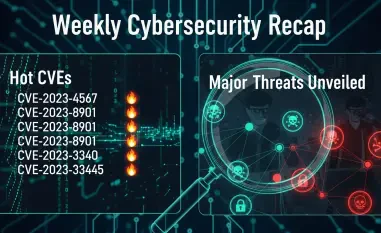The evolution and persistence of the Grandoreiro banking malware present significant threats to financial institutions on a global scale. Initially focused on Latin America and Europe, this malware has significantly broadened its scope, now targeting banks in 45 countries. A detailed analysis reveals how Grandoreiro employs sophisticated, multi-faceted evasion techniques, showcasing an advanced grasp of security systems and a relentless drive to stay ahead of detection protocols.
Sophisticated Evasion Techniques
Grandoreiro’s creators have meticulously integrated advanced evasion tactics that allow the malware to effectively hide from security systems. Among the most prominent methods is sandbox evasion. The malware uses large portable executable files that are cleverly disguised as legitimate AMD External Data SSD drivers. By using these large, seemingly benign files, the malware manages to evade detection within sandbox environments set up by security analysts to identify malicious activities. This evasion technique enables Grandoreiro to operate undetected for extended periods, posing a serious challenge to cybersecurity professionals tasked with identifying and neutralizing the threat.
Another essential tactic in Grandoreiro’s arsenal is the use of Domain Generation Algorithms (DGA). DGAs allow the malware to systematically produce new domain names for its command-and-control (C2) communications. This technique significantly fortifies the malware’s resilience by establishing secure communication channels that are challenging to predict and subsequently block. The systematic generation of these domain names complicates efforts to track and disrupt the malware’s network, thereby ensuring the uninterrupted operation of its malicious activities and data theft schemes.
Distribution Methods and Global Reach
Despite the stringent security measures commonly implemented by companies and individuals, Grandoreiro primarily spreads through phishing emails. These emails are painstakingly crafted to appear as legitimate communications from trusted entities, increasing the likelihood that recipients will be duped into downloading the malicious payload. Additionally, Grandoreiro employs malicious advertisements as a secondary distribution strategy. These ads, often appearing on platforms like Google, exploit lapses in ad monitoring and removal processes to further disseminate the malware.
From its origins in Latin America, the malware’s global reach has now expanded to include Europe and several other regions. Currently, Grandoreiro targets 1,700 financial institutions across 45 countries, demonstrating a deliberate and calculated approach to infiltrating various banking systems. This extensive geographical expansion highlights the adaptability and persistent efforts of the malware’s operators, who continually refine their tactics to overcome the defenses of financial institutions worldwide.
Adaptive Threat Model
At its core, Grandoreiro is engineered to collect extensive host information. It gathers details about system configurations and user behaviors, allowing it to assess the presence of anti-malware software and other defenses. If the environment indicates a high likelihood of detection, Grandoreiro will cease its operations to avoid exposure. This capability underscores the malware’s highly intelligent and adaptive nature, enabling it to modify its behavior according to different security landscapes and diminish the risk of being identified.
Beyond its primary focus on targeting banking information, Grandoreiro also functions as a clipper for cryptocurrency transactions. It intercepts and reroutes these transactions to wallets controlled by the attackers, reflecting its versatile capabilities. Furthermore, the malware includes mechanisms for self-updating, which underscores its durability and capacity for continuous evolution. This allows Grandoreiro to adapt to newly emerging threats in real-time, making it a persistent and formidable adversary for cybersecurity professionals.
Exploitation of Legitimate Software
One of the most cunning tactics used by Grandoreiro is DLL sideloading. This process involves executing the malware using digitally signed, legitimate binaries, making detection particularly difficult. By exploiting trusted software certificates, Grandoreiro can effectively conceal itself within systems that rely on such certificates for security verification. This tactic highlights a broader trend in malware development, wherein attackers leverage trust mechanisms to execute their exploits more effectively, making traditional security approaches less effective against these advanced threats.
Grandoreiro also incorporates sophisticated monitoring capabilities to bolster its espionage efforts. It logs keystrokes and monitors Outlook email messages for specific keywords, enabling it to collect sensitive information without triggering suspicion. These advanced features confirm Grandoreiro’s status as a formidable and persistent threat in the cybersecurity landscape, continually evolving to outsmart defense mechanisms set up by security experts.
Strategic Targeting and Localization
The evolution and persistence of the Grandoreiro banking malware present significant threats to financial institutions globally. Originally concentrating on Latin America and Europe, this malware has now remarkably widened its reach, targeting banks in 45 countries. Through detailed analysis, it becomes clear that Grandoreiro employs sophisticated, multi-layered evasion strategies, demonstrating an advanced understanding of security systems and a relentless drive to outpace detection measures. The malware utilizes techniques such as process hollowing, keylogging, and screen capturing to steal sensitive information and evade traditional antivirus software. Its ability to adapt and innovate continuously highlights the urgent need for financial institutions to invest in robust cybersecurity measures and stay ahead of these evolving threats. In addition, the malware often disguises itself as legitimate software updates, tricking users into installing it unknowingly. This underscores the importance of constant vigilance, user education, and advanced threat detection systems to safeguard against such insidious threats.













